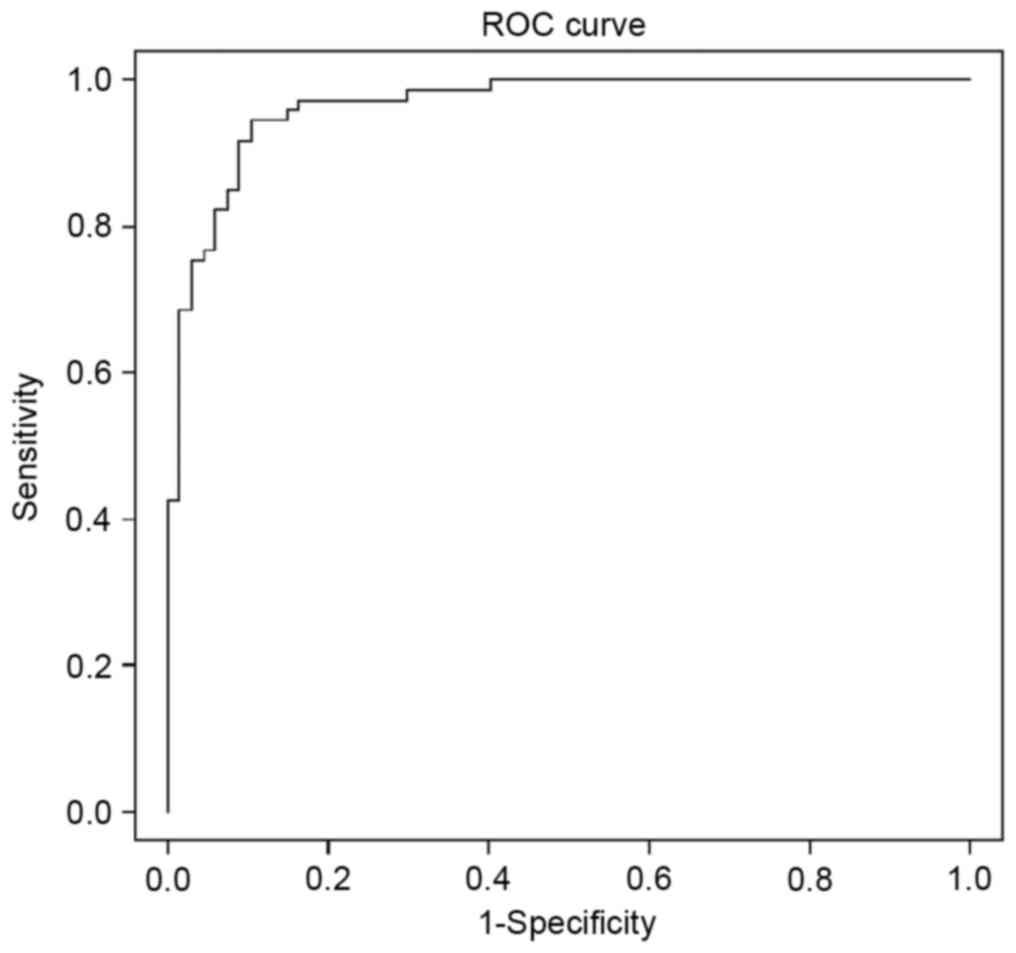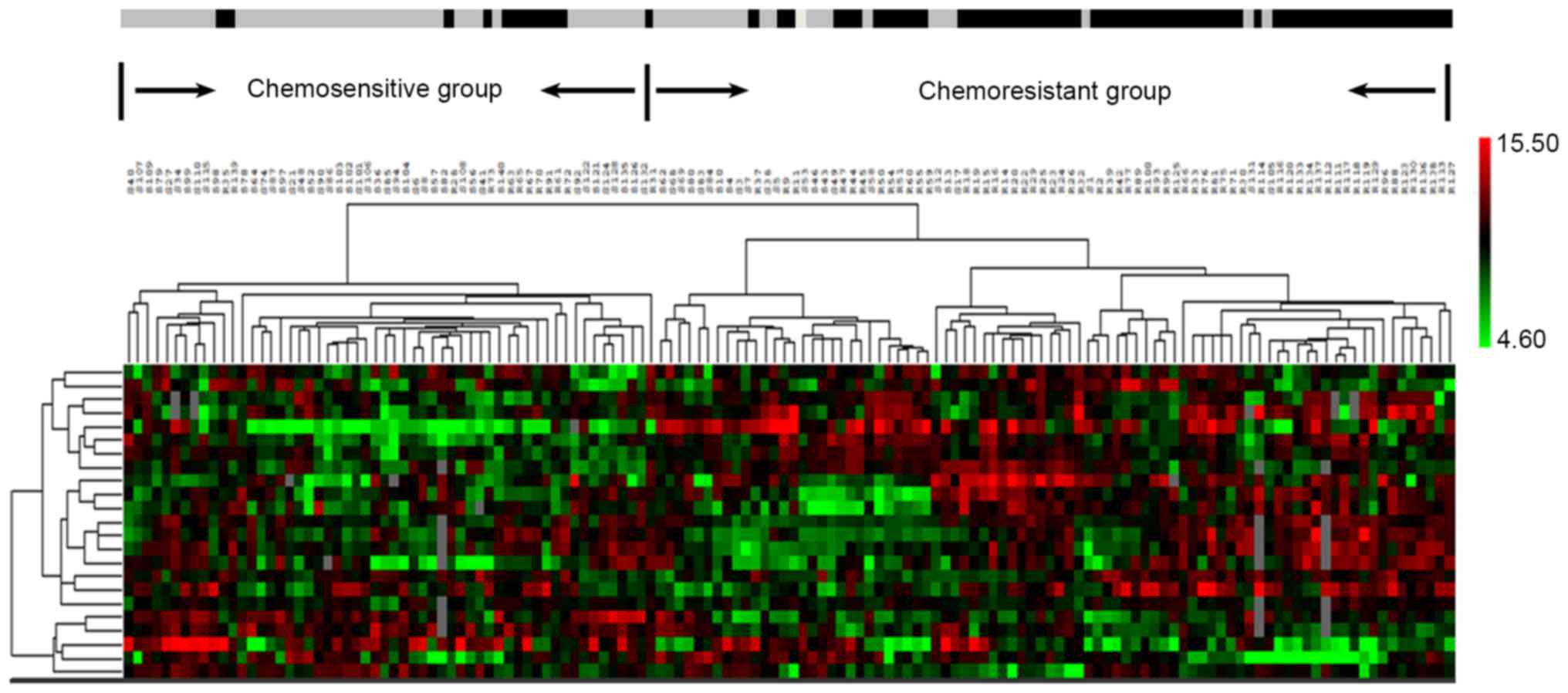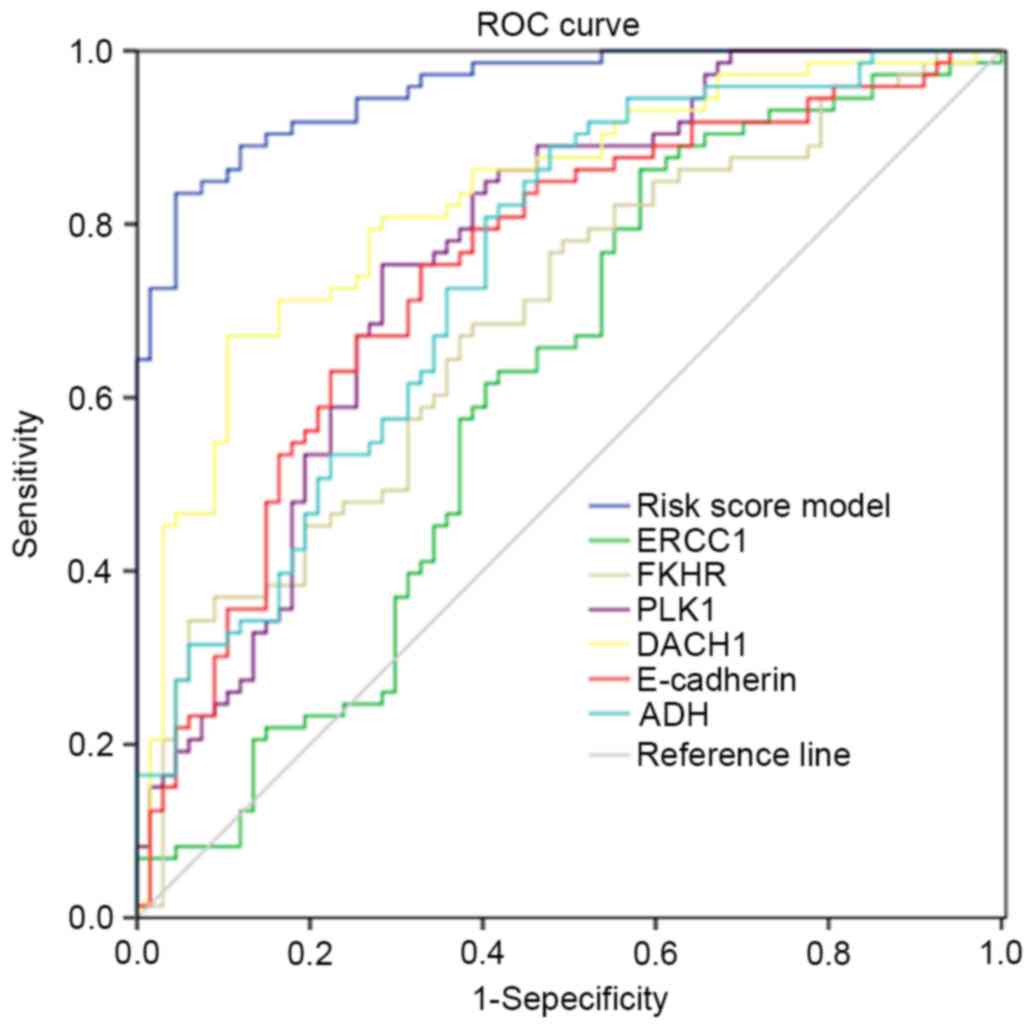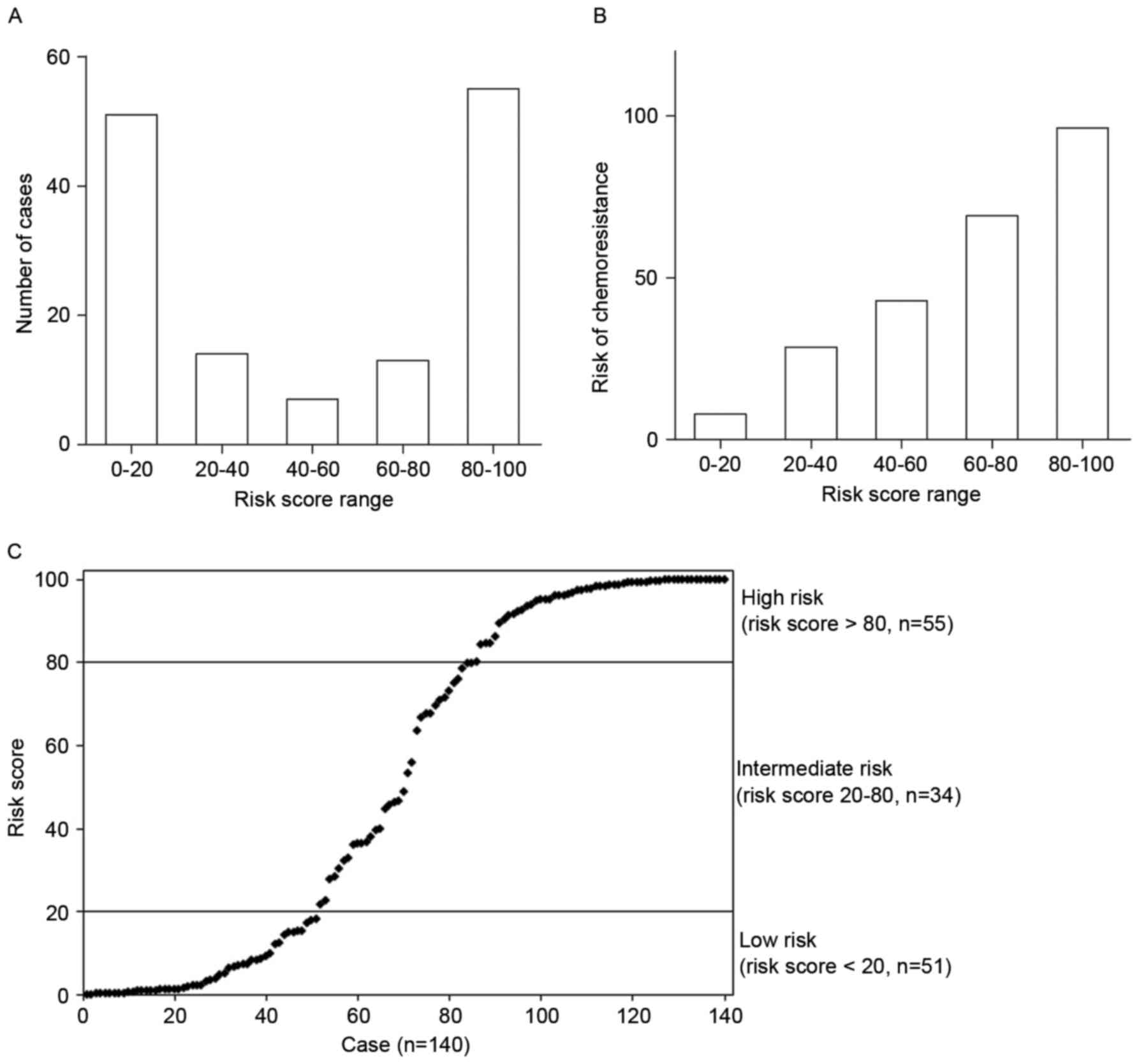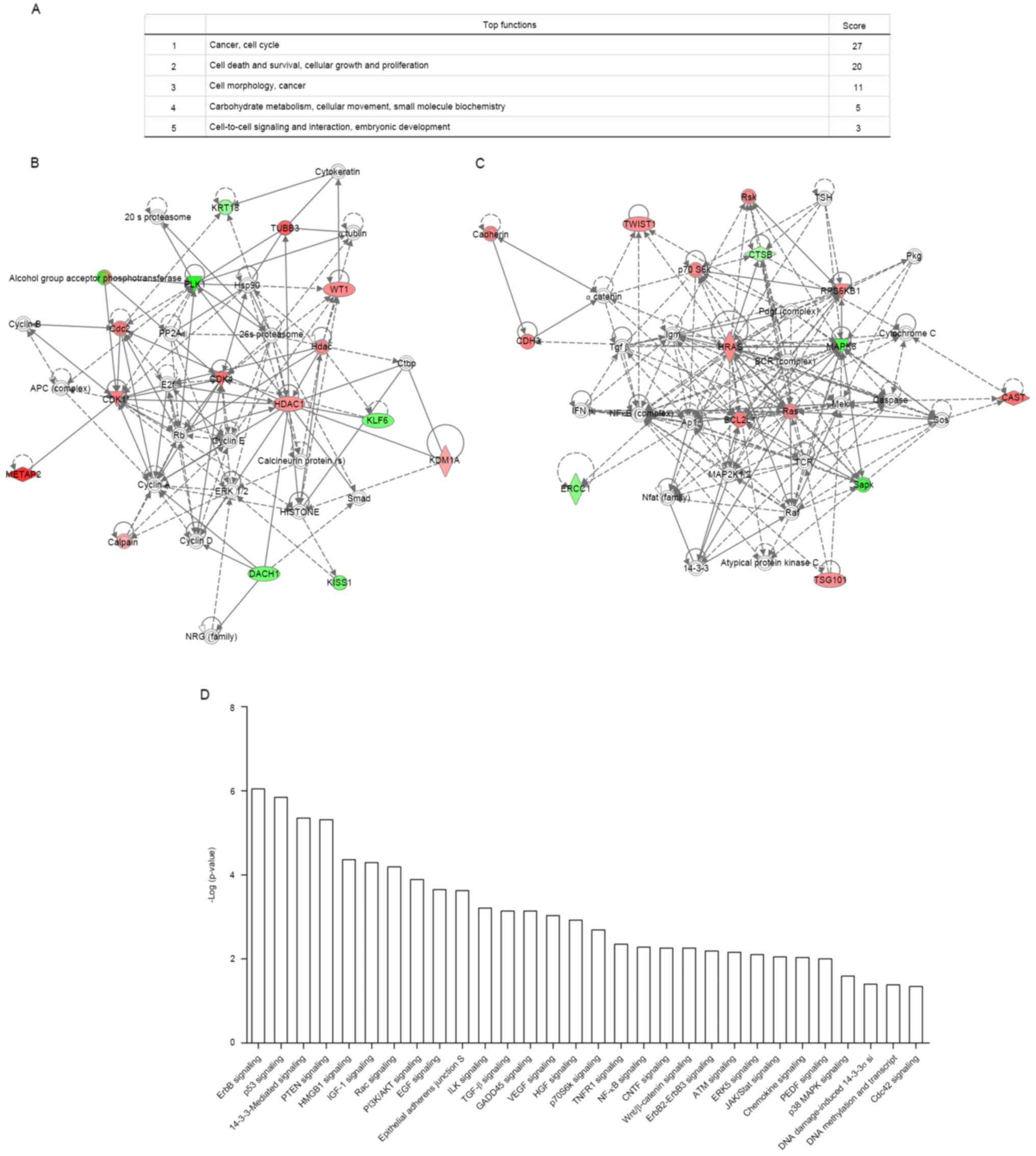|
1
|
Fox JG and Wang TC: Inflammation, atrophy,
and gastric cancer. J Clin Invest. 117:60–69. 2007. View Article : Google Scholar : PubMed/NCBI
|
|
2
|
Jemal A, Bray F, Center MM, Ferlay J, Ward
E and Forman D: Global cancer statistics. CA Cancer J Clin.
61:69–90. 2011. View Article : Google Scholar : PubMed/NCBI
|
|
3
|
Nakajima T, Kinoshita T, Nashimoto A,
Sairenji M, Yamaguchi T, Sakamoto J, Fujiya T, Inada T, Sasako M
and Ohashi Y; National Surgical Adjuvant Study of Gastric Cancer
Group, : Randomized controlled trial of adjuvant uracil-tegafur
versus surgery alone for serosa-negative, locally advanced gastric
cancer. Br J Surg. 94:1468–1476. 2007. View
Article : Google Scholar : PubMed/NCBI
|
|
4
|
Sasako M, Sakuramoto S, Katai H, Kinoshita
T, Furukawa H, Yamaguchi T, Nashimoto A, Fujii M, Nakajima T and
Ohashi Y: Five-year outcomes of a randomized phase III trial
comparing adjuvant chemotherapy with S-1 versus surgery alone in
stage II or III gastric cancer. J Clin Oncol. 29:4387–4393. 2011.
View Article : Google Scholar : PubMed/NCBI
|
|
5
|
Bang YJ, Kim YW, Yang HK, Chung HC, Park
YK, Lee KH, Lee KW, Kim YH, Noh SI, Cho JY, et al CLASSIC trial
investigators, : Adjuvant capecitabine and oxaliplatin for gastric
cancer after D2 gastrectomy (CLASSIC): A phase 3 open-label,
randomised controlled trial. Lancet. 379:315–321. 2012. View Article : Google Scholar : PubMed/NCBI
|
|
6
|
Di Costanzo F, Gasperoni S, Manzione L,
Bisagni G, Labianca R, Bravi S, Cortesi E, Carlini P, Bracci R,
Tomao S, et al Italian Oncology Group for Cancer Research, :
Adjuvant chemotherapy in completely resected gastric cancer: A
randomized phase III trial conducted by GOIRC. J Natl Cancer Inst.
100:388–398. 2008. View Article : Google Scholar : PubMed/NCBI
|
|
7
|
Cunningham D, Allum WH, Stenning SP,
Thompson JN, Van de Velde CJ, Nicolson M, Scarffe JH, Lofts FJ,
Falk SJ, Iveson TJ, et al MAGIC Trial Participants, : Perioperative
chemotherapy versus surgery alone for resectable gastroesophageal
cancer. N Engl J Med. 355:11–20. 2006. View Article : Google Scholar : PubMed/NCBI
|
|
8
|
Arnold CN, Goel A and Boland CR: Role of
hMLH1 promoter hypermethylation in drug resistance to
5-fluorouracil in colorectal cancer cell lines. Int J Cancer.
106:66–73. 2003. View Article : Google Scholar : PubMed/NCBI
|
|
9
|
Violette S, Poulain L, Dussaulx E, Pepin
D, Faussat AM, Chambaz J, Lacorte JM, Staedel C and Lesuffleur T:
Resistance of colon cancer cells to long-term 5-fluorouracil
exposure is correlated to the relative level of Bcl-2 and Bcl-XL in
addition to Bax and p53 status. Int J Cancer. 98:498–504. 2002.
View Article : Google Scholar : PubMed/NCBI
|
|
10
|
Liu R, Page C, Beidler DR, Wicha MS and
Núñez G: Overexpression of Bcl-xL promotes chemotherapy resistance
of mammary tumors in a syngeneic mouse model. Am J Pathol.
155:1861–1867. 1999. View Article : Google Scholar : PubMed/NCBI
|
|
11
|
Shi X, Liu S, Kleeff J, Friess H and
Büchler MW: Acquired resistance of pancreatic cancer cells towards
5-Fluorouracil and gemcitabine is associated with altered
expression of apoptosis-regulating genes. Oncology. 62:354–362.
2002. View Article : Google Scholar : PubMed/NCBI
|
|
12
|
Viniegra J Guinea, Hernández Losa J,
Sánchez-Arévalo VJ, Cobo C Parada, Fernández, Soria VM, Ramón y
Cajal S and Sánchez-Prieto R: Modulation of PI3K/Akt pathway by E1a
mediates sensitivity to cisplatin. Oncogene. 21:7131–7136. 2002.
View Article : Google Scholar : PubMed/NCBI
|
|
13
|
Machuy N, Rajalingam K and Rudel T:
Requirement of caspase-mediated cleavage of c-Abl during
stress-induced apoptosis. Cell Death Differ. 11:290–300. 2004.
View Article : Google Scholar : PubMed/NCBI
|
|
14
|
Vekris A, Meynard D, Haaz MC, Bayssas M,
Bonnet J and Robert J: Molecular determinants of the cytotoxicity
of platinum compounds: The contribution of in silico research.
Cancer Res. 64:356–362. 2004. View Article : Google Scholar : PubMed/NCBI
|
|
15
|
Shu C, Liu Z, Cui L, Wei C, Wang S, Tang
JJ, Cui M, Lian G, Li W, Liu X, et al: Protein profiling of
preeclampsia placental tissues. PLoS One. 9:e112890. 2014.
View Article : Google Scholar : PubMed/NCBI
|
|
16
|
Wildiers H and Brain E: Different adjuvant
chemotherapy regimens in older breast cancer patients? Ann Oncol.
26:613–615. 2015. View Article : Google Scholar : PubMed/NCBI
|
|
17
|
Nabeya Y, Suzuki T, Furuya A, Koide N,
Ohkoshi M, Takiguchi M, Ochiai T, Matsubara H and Hiwasa T: Calpain
regulates thymidylate synthase-5-fluoro-dUMP complex levels
associated with response to 5-fluorouracil in gastric cancer cells.
Cancer Sci. 102:1509–1515. 2011. View Article : Google Scholar : PubMed/NCBI
|
|
18
|
Yin M, Yan J, Martinez-Balibrea E,
Graziano F, Lenz HJ, Kim HJ, Robert J, Im SA, Wang WS,
Etienne-Grimaldi MC, et al: ERCC1 and ERCC2 polymorphisms predict
clinical outcomes of oxaliplatin-based chemotherapies in gastric
and colorectal cancer: A systemic review and meta-analysis. Clin
Cancer Res. 17:1632–1640. 2011. View Article : Google Scholar : PubMed/NCBI
|
|
19
|
Sève P and Dumontet C: Is class III
beta-tubulin a predictive factor in patients receiving
tubulin-binding agents? Lancet Oncol. 9:168–175. 2008. View Article : Google Scholar : PubMed/NCBI
|
|
20
|
Carneiro P, Figueiredo J, Bordeira-Carriço
R, Fernandes MS, Carvalho J, Oliveira C and Seruca R: Therapeutic
targets associated to E-cadherin dysfunction in gastric cancer.
Expert Opin Ther Targets. 17:1187–1201. 2013. View Article : Google Scholar : PubMed/NCBI
|
|
21
|
Yamada Y, Arao T, Gotoda T, Taniguchi H,
Oda I, Shirao K, Shimada Y, Hamaguchi T, Kato K, Hamano T, et al:
Identification of prognostic biomarkers in gastric cancer using
endoscopic biopsy samples. Cancer Sci. 99:2193–2199. 2008.
View Article : Google Scholar : PubMed/NCBI
|
|
22
|
Ahmed I, Debray TP, Moons KG and Riley RD:
Developing and validating risk prediction models in an individual
participant data meta-analysis. BMC Med Res Methodol. 14:32014.
View Article : Google Scholar : PubMed/NCBI
|
|
23
|
Spitz MR, Hong WK, Amos CI, Wu X, Schabath
MB, Dong Q, Shete S and Etzel CJ: A risk model for prediction of
lung cancer. J Natl Cancer Inst. 99:715–726. 2007. View Article : Google Scholar : PubMed/NCBI
|
|
24
|
Marcus MW, Raji OY, Duffy SW, Young RP,
Hopkins RJ and Field JK: Incorporating epistasis interaction of
genetic susceptibility single nucleotide polymorphisms in a lung
cancer risk prediction model. Int J Oncol. 49:361–370. 2016.
View Article : Google Scholar : PubMed/NCBI
|
|
25
|
Oki E, Baba H, Tokunaga E, Nakamura T,
Ueda N, Futatsugi M, Mashino K, Yamamoto M, Ikebe M, Kakeji Y, et
al: Akt phosphorylation associates with LOH of PTEN and leads to
chemoresistance for gastric cancer. Int J Cancer. 117:376–380.
2005. View Article : Google Scholar : PubMed/NCBI
|
|
26
|
Krämer A, Green J, Pollard J Jr and
Tugendreich S: Causal analysis approaches in Ingenuity Pathway
Analysis. Bioinformatics. 30:523–530. 2014. View Article : Google Scholar : PubMed/NCBI
|
|
27
|
Tan M and Yu D: Molecular mechanisms of
erbB2-mediated breast cancer chemoresistance. Adv Exp Med Biol.
608:119–129. 2007. View Article : Google Scholar : PubMed/NCBI
|
|
28
|
Rohwer N, Dame C, Haugstetter A,
Wiedenmann B, Detjen K, Schmitt CA and Cramer T: Hypoxia-inducible
factor 1α determines gastric cancer chemosensitivity via modulation
of p53 and NF-kappaB. PLoS One. 5:e12038. 2010. View Article : Google Scholar : PubMed/NCBI
|
|
29
|
Zhao J, Meyerkord CL, Du Y, Khuri FR and
Fu H: 14-3-3 proteins as potential therapeutic targets. Semin Cell
Dev Biol. 22:705–712. 2011. View Article : Google Scholar : PubMed/NCBI
|
|
30
|
Li J, Zhang Y, Zhao J, Kong F and Chen Y:
Overexpression of miR-22 reverses paclitaxel-induced
chemoresistance through activation of PTEN signaling in p53-mutated
colon cancer cells. Mol Cell Biochem. 357:31–38. 2011. View Article : Google Scholar : PubMed/NCBI
|















